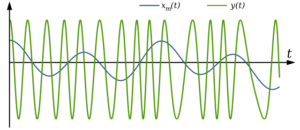
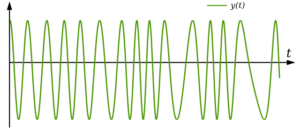
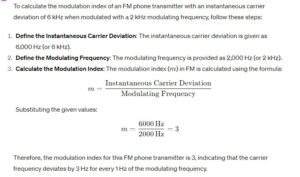
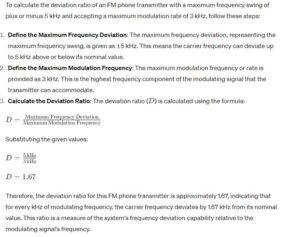
Start Here
Exploring the Depths of FM Transmission
Throughout this chapter, we have explored various aspects crucial to understanding and effectively managing FM transmission systems. Starting with the modulation index, we learned how it quantifies the extent of frequency deviation in response to the modulating signal, directly influencing the FM signal’s bandwidth and quality. We discussed the deviation ratio, a vital parameter that helps determine the maximum modulation rate for stable FM transmission. Further, the role of deviation meters in measuring frequency deviation was examined, emphasizing their importance in maintaining transmission standards and ensuring signal integrity. By delving into these topics, this chapter provided a detailed perspective on the technical nuances of FM broadcasting, from the basic principles governing frequency deviation to the practical tools used for monitoring and adjusting FM signals. Armed with this knowledge, readers are better equipped to appreciate the complexities of FM transmission and its pivotal role in modern communication systems.
Be sure to login to your hamshack.ca account to track your progress by clicking the [Mark Complete] Button at the bottom of each lesson. You can contact VE7DXE to sign-up for the new Basic Amateur course.
The Essence of Modulation Index (A-005-005-001)
Understanding the modulation index is fundamental in the study of Frequency Modulation (FM) as it directly influences both the quality and bandwidth of the transmitted signal. In the context of question A-005-005-001, where a signal exhibits a maximum frequency deviation of 3000 Hz either side of the carrier, and the modulating frequency is 1000 Hz, the modulation index is determined through a straightforward calculation:
- Modulation Index = Frequency Deviation / Modulating Frequency
- Therefore, Modulation Index = 3000 Hz / 1000 Hz = D: 3
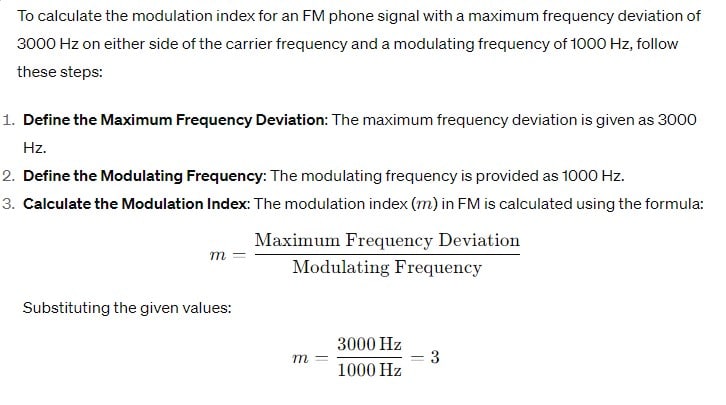
This calculation yields a modulation index of 3, underscoring the ratio of the carrier frequency’s deviation to the frequency of the modulating signal. This index is a crucial determinant of the FM signal’s characteristics, affecting its bandwidth and the fidelity of the transmitted information. A higher modulation index means a greater deviation from the carrier frequency, which can improve the transmitted signal’s clarity and quality but also requires more bandwidth.
The modulation index not only affects the technical aspects of transmission but also the practical considerations in broadcasting. It serves as a critical parameter in designing FM systems, ensuring they meet both regulatory standards and the desired quality of communication. Through understanding and optimizing the modulation index, amateur radio operators can effectively manage their signal’s impact on the radio spectrum, balancing between achieving high audio quality and minimizing interference with adjacent channels.
Parallels:
- Volume Control on a Music Player: Adjusting the volume on a music player changes the audio output’s loudness without altering the track. Similarly, the modulation index adjusts how far the FM signal deviates from its carrier frequency, affecting the ‘loudness’ or clarity of the transmitted message without changing the message itself.
- Using a Zoom Lens on a Camera: Zooming in with a camera lens captures more detail of the subject but narrows the field of view. Analogously, a higher modulation index captures more details of the audio signal (increasing frequency deviation) but requires more bandwidth, akin to needing a wider ‘view’ or spectrum.
Question Summary and Key Takeaways:
- The modulation index is calculated as the ratio of frequency deviation to modulating frequency, significant for FM signal quality and bandwidth.
- A modulation index of 3 indicates the carrier frequency deviates three times for every unit of modulating frequency, impacting signal clarity and bandwidth usage.
- This concept is pivotal for optimizing FM transmission, ensuring a balance between audio quality and efficient use of the radio spectrum.
- Practical application of the modulation index allows for enhanced communication quality while adhering to spectrum management regulations.
- Understanding and managing the modulation index is essential for advanced amateur radio operations, facilitating effective and efficient broadcast practices.
Modulation Index in Complex Signals (A-005-005-002)
Deep Dive into Modulation Index with Complex Signals
Question A-005-005-002 propels us further into the exploration of the modulation index, this time within the context of an FM phone transmitter that produces an instantaneous carrier deviation of 6 kHz when modulated by a 2 kHz frequency. The formula for calculating the modulation index remains the same:
- Modulation Index (m) = Frequency Deviation (Delta f) / Modulating Frequency (f_m)
Using the given values:
- m = 6000 Hz / 2000 Hz = D: 3

This yields a modulation index of 3, consistent with our previous example, reinforcing the concept that the modulation index reflects how extensively the carrier frequency deviates in response to the modulating signal. In this scenario, the modulation index further exemplifies the transmitter’s capability to handle a higher deviation with a relatively low modulating frequency, ensuring that the transmitted signal is robust against noise and interference while also being efficiently confined within the allocated bandwidth.
The Role of Modulation Index in Signal Quality and Bandwidth
The consistent modulation index in varying scenarios underlines its critical role in FM transmission. A modulation index of 3 indicates a well-balanced approach to frequency deviation, optimizing the trade-off between signal clarity and bandwidth usage. It is imperative for amateur radio operators to understand this balance, as it directly impacts the effectiveness of their communication in terms of both reach and fidelity.
Moreover, the modulation index’s influence extends beyond basic transmission characteristics to affect the system’s overall performance, including its ability to convey information with minimal distortion and its resilience in the face of channel imperfections. Therefore, mastering the modulation index calculation and its implications is invaluable for advanced amateur radio enthusiasts seeking to enhance their operational capabilities and optimize their use of the radio spectrum.
Parallels:
- Tuning a Musical Instrument: Adjusting the tension on a guitar string to change its pitch is akin to modulating the carrier frequency in FM transmission. Just as a string’s tension determines the note’s pitch and clarity (similar to the modulation index affecting signal quality), too much tension can snap the string or make it difficult to play (comparable to excessive deviation consuming too much bandwidth).
- Navigating a Vehicle: Driving a car involves adjusting speed in response to road conditions. Similarly, the modulation index adjusts the carrier frequency’s deviation in response to the modulating signal. Just as moderate speed ensures a smooth ride without veering off the road (akin to a balanced modulation index ensuring signal clarity without excessive bandwidth use), understanding when and how to adjust is key to reaching the destination efficiently and safely.
Question Summary and Key Takeaways:
- The modulation index remains a pivotal factor in FM transmission, indicating the carrier frequency’s deviation due to the modulating signal.
- A consistent modulation index of 3 across different scenarios showcases its importance in maintaining signal integrity and bandwidth efficiency.
- This concept aids operators in optimizing FM transmission quality while adhering to spectrum regulations.
- The modulation index’s role in enhancing system performance and resilience against interference cannot be overstated.
- Understanding and applying the modulation index is crucial for advanced amateur radio operations, ensuring effective and efficient communication.
Navigating Deviation Ratios in FM Transmission (A-005-005-003)
The deviation ratio in FM transmission offers a lens through which to examine how the maximum frequency swing relates to the maximum allowable modulation rate. Question A-005-005-003 introduces a scenario with a maximum frequency swing of plus or minus 5 kHz and a maximum modulation rate of 3 kHz. The deviation ratio is determined by dividing the maximum frequency deviation by the maximum modulation frequency:
- Deviation Ratio = Maximum Frequency Swing / Maximum Modulation Rate
Given the values:
- Deviation Ratio = (5 kHz) / (3 kHz) = 1.66

A deviation ratio of 1.66 signifies the extent to which the carrier frequency can vary relative to the modulation rate, offering insights into the flexibility and potential constraints of the FM transmission system. A higher deviation ratio suggests a wider range for frequency deviation, potentially enhancing the quality of the transmitted signal but also implying a greater demand on bandwidth.
The Significance of Deviation Ratio in FM Systems
Understanding the deviation ratio is crucial for amateur radio operators, especially when configuring transmitters to achieve optimal performance within the constraints of their operating licenses. The deviation ratio directly impacts the transmitter’s ability to convey information clearly and without distortion, affecting both the audio quality and the spectral footprint of the transmission.
Moreover, the deviation ratio plays a pivotal role in system design and regulatory compliance, ensuring that transmissions do not exceed bandwidth allocations and interfere with adjacent channels. Balancing the deviation ratio is thus a key aspect of effective FM transmission, necessitating a thorough grasp of both theoretical concepts and practical application by advanced amateur radio practitioners.
Parallels:
- Filling a Container with Water: Imagine filling a container with water where the flow rate can be adjusted. The container’s size represents the maximum frequency deviation, and the flow rate knob represents the modulation rate. Adjusting the flow rate to fill the container efficiently without spilling over is akin to managing the deviation ratio in FM transmission, ensuring optimal use of available bandwidth without exceeding limits.
- Adjusting the Brightness of a Screen: The deviation ratio can be likened to adjusting the brightness settings on a digital screen. Just as the right brightness level enhances viewing comfort and detail without straining the eyes (akin to an optimal deviation ratio improving signal quality), excessive brightness can lead to discomfort and unnecessary power consumption (comparable to excessive deviation consuming too much bandwidth).
Question Summary and Key Takeaways:
- The deviation ratio measures the carrier frequency’s maximum deviation relative to the modulation rate in FM transmission.
- A deviation ratio of 1.66 indicates a system capable of significant frequency variation, enhancing signal quality within bandwidth constraints.
- This metric is critical for optimizing transmission performance and ensuring regulatory compliance.
- Balancing the deviation ratio is essential for maintaining high audio quality and efficient bandwidth usage.
- Advanced amateur radio operators must understand and manage the deviation ratio to maximize the effectiveness of their FM transmission systems.
Deviation Ratios and Their Impact on FM Transmission Quality (A-005-005-004)
Analytical Overview of Deviation Ratios
The deviation ratio in Frequency Modulation (FM) transmission quantitatively describes the relationship between maximum frequency deviation and maximum modulation frequency. Within the context provided by question A-005-005-004, involving an FM phone transmitter with a frequency swing of ±7.5 kHz and a modulation rate of 3.5 kHz, the deviation ratio is calculated as follows:
- Deviation Ratio = Maximum Frequency Swing / Maximum Modulation Rate
Applying the specified values:
- Deviation Ratio = 7.5 kHz / 3.5 kHz = 2.14
This ratio, 2.14, indicates a system’s enhanced ability to vary its frequency in reaction to the modulating signal, suggesting potential improvements in the transmitted audio’s fidelity. However, this comes with an implication of increased bandwidth usage. A higher deviation ratio, as demonstrated, signifies the system’s improved dynamic range, allowing for a more detailed transmission of audio content but necessitating careful bandwidth management.
Theoretical and Practical Considerations of Deviation Ratios
The deviation ratio is integral to FM system design, informing the balance between signal quality and bandwidth utilization. It embodies the technical decisions underlying the system’s configuration, ensuring audio transmissions are both clear and compliant with spectrum usage regulations. This balance is critical in environments where bandwidth is limited, and spectrum efficiency is paramount.
Moreover, the deviation ratio’s significance extends to its impact on adjacent channel interference. A carefully calibrated deviation ratio can mitigate the risk of encroaching on adjacent frequencies, thereby upholding the integrity of the communication channel and adhering to regulatory standards. Thus, the deviation ratio not only influences the qualitative aspects of FM transmission but also plays a vital role in spectrum management and regulatory compliance.
Conceptual Parallels to Deviation Ratios
- Optical Focus in Photography: The adjustment of a camera’s focus to achieve clarity in photographic images mirrors the calibration of deviation ratios in FM transmission. Just as precise focus optimization enhances image quality without exceeding the lens’s capabilities, an optimal deviation ratio ensures audio clarity without surpassing bandwidth limitations.
- Thermal Regulation in Engineering Systems: The management of temperature in mechanical systems through controlled heat dissipation parallels the regulation of deviation ratios in FM broadcasting. Effective thermal management ensures system efficiency and longevity, akin to how a well-managed deviation ratio guarantees signal fidelity and efficient spectrum use.
Concluding Insights and Implications
- The deviation ratio, standing at 2.14 for the given scenario, highlights a system’s capability for significant frequency variation, enhancing audio transmission quality.
- It underscores the necessity of balancing signal fidelity with bandwidth consumption, a critical aspect of FM system design.
- The deviation ratio is instrumental in minimizing adjacent channel interference, ensuring efficient use of the radio spectrum.
- Proper management of deviation ratios is essential for compliance with spectrum regulations, reflecting the technical acumen required in advanced FM broadcasting.
- Theoretical understanding and practical application of deviation ratios are crucial for optimizing FM transmission systems, underscoring their importance in contemporary radio communications.
Center Frequency of Unmodulated FM Transmitters (A-005-005-005)
Understanding Center Frequency in FM: Question A-005-005-005 focuses on identifying the carrier frequency of an FM transmitter when it’s not modulated or when the modulating signal’s amplitude is zero. The correct answer is C. Centre frequency. This term refers to the unmodulated, or base, frequency of the FM transmitter. It’s the frequency around which the FM signal varies when modulated. The concept is similar to a resting heart rate in humans – the baseline frequency around which modulation causes variations.
Parallels:
- Resting Heart Rate: Just as a resting heart rate is the baseline for heart activity, the center frequency is the baseline around which FM modulation occurs.
- Calm Sea Level: Similar to a calm sea level before waves begin to form, the center frequency is the stable state of an FM transmitter before modulation.
Question Summary and Key Takeaways:
- Centre Frequency Defined: The unmodulated frequency of an FM transmitter.
- Baseline for Modulation: Serves as the reference point for frequency deviation.
- Constant in the Absence of Modulation: Remains stable when there’s no modulating signal.
- Crucial for Frequency Stability: Ensures the transmitter has a fixed reference frequency.
- Key in FM Transmission: Understanding center frequency is essential for accurate FM broadcasting.
Deviation from Centre Frequency in FM (A-005-005-006)
Determinants of Frequency Deviation in FM: In Question A-005-005-006, the query is about what determines the amount of deviation from the center frequency in an FM transmitter system. The correct answer, D. Amplitude of the modulating frequency, indicates that the extent of frequency deviation is solely determined by the amplitude of the modulating signal. The higher the amplitude of the modulating signal, the greater the frequency deviation from the center frequency. It’s akin to pressing piano keys; the harder you press, the louder (and in FM terms, the more deviated) the note.
Parallels:
- Piano Key Pressure: Similar to how pressing a piano key harder produces a louder sound, higher amplitude in FM leads to greater frequency deviation.
- Accelerating a Car: Just as pressing the accelerator pedal more deeply increases a car’s speed, higher amplitude modulation results in more significant frequency variation.
Question Summary and Key Takeaways:
- Amplitude Determines Deviation: The strength of the modulating signal directly affects frequency changes.
- Key Factor in FM Systems: Central to understanding how FM transmitters operate.
- Direct Relationship: Stronger signals lead to more pronounced frequency shifts.
- Essential for Modulation Control: Managing amplitude is crucial for desired frequency deviation.
- Fundamental Concept in FM Broadcasting: Understanding this principle is vital for effective FM transmission design and operation.
Sideband Frequencies in Single-Tone Modulated FM (A-005-005-007)
Infinite Sidebands in FM Wave: Question A-005-005-007 asks about the number of sideband frequencies generated in an FM wave when modulated with a single tone. The answer, B. An infinite number of sideband frequencies, reflects the complex nature of FM modulation. When an FM wave is modulated with just a single tone, it produces an endless series of sidebands at various frequencies around the carrier. This phenomenon is a result of the way frequency modulation works, with each modulating frequency component generating pairs of sidebands at intervals from the carrier frequency. It’s somewhat like ripples in water, where a single disturbance can create countless waves spreading outwards.
Parallels:
- Ripples in Water: A single stone thrown into a pond creates endless ripples, just as a single-tone modulation in FM produces infinite sidebands.
- Echoes in a Canyon: Like a single shout in a canyon producing multiple echoes, a single-tone modulation in FM results in countless sideband frequencies.
Question Summary and Key Takeaways:
- Infinite Sidebands in FM: A single-tone modulation leads to endless sidebands.
- Result of Frequency Modulation: Reflects the inherent characteristics of FM.
- Complex Spectral Content: Demonstrates the intricate nature of FM signals.
- Importance for Signal Analysis: Understanding this is crucial for effective FM signal processing.
- Implications for Bandwidth: Affects how much spectrum space an FM signal occupies.
Working Principle of Deviation Meters (A-005-005-008)
Principle of Deviation Meters in FM:
Deviation meters are crucial instruments in radio frequency (RF) engineering, particularly for measuring the frequency deviation of modulated signals, such as those used in frequency modulation (FM) and phase modulation (PM). The principle upon which a deviation meter operates can significantly affect its accuracy, application, and suitability for specific types of measurements. The correct answer to the question, which seeks to identify the operating principle of some types of deviation meters, is C) a carrier null and multiplying the modulation frequency by the modulation index. This method involves precisely nulling (or minimizing) the carrier signal to isolate the effect of modulation, and then using the modulation frequency and index to calculate the deviation.
This principle is based on the understanding that the deviation of an FM or PM signal is directly related to the characteristics of the modulating signal and the modulation index. The modulation index in FM is defined as the ratio of the frequency deviation to the modulation frequency. By nulling the carrier, the deviation meter focuses on the variations caused by the modulating signal, allowing for a direct relationship between the observed modulation effects and the actual frequency deviation.
Note: there is a discrepancy between the Spectrum Management and Telecommunications Advanced Qualification Question Bank which shows (D) as the correct answer for this question. The correct provided on-line at https://ised-isde.canada.ca/site/amateur-radio-operator-certificate-services/en/amateur-radio-exam-generator indicates the correct answer is (C)

Parallels
- Balancing Scales: Imagine using a balance scale where you aim to find the exact point at which both sides are equally weighted, achieving a perfect balance. This scenario is akin to the process of achieving a carrier null in deviation meter measurements. Just as the balance indicates when the weights on both sides are equal, a deviation meter indicates when the carrier has been effectively nullified, allowing for precise deviation measurements based on the modulation characteristics.
- Tuning a Musical Instrument: Consider the process of tuning a string instrument, where you adjust the tension of the strings until the pitch produced matches a reference note perfectly. This adjustment process is similar to manipulating a deviation meter to achieve a carrier null. In both cases, fine adjustments are made to reach an optimal point—nulling the carrier in one, and achieving the correct pitch in the other—before measuring or assessing the resulting quality (deviation or musical tone).
Question Summary and Key Takeaways
- Some types of deviation meters operate based on achieving a carrier null and then utilizing the modulation frequency and modulation index to calculate frequency deviation.
- This principle allows for precise measurements by isolating the effects of modulation from the carrier signal, providing a clear assessment of deviation.
- Understanding the operation of deviation meters is essential for accurately setting up and assessing the performance of FM and PM transmission systems.
- The analogy to balancing scales and tuning a musical instrument helps illustrate the concept of achieving a carrier null as a prerequisite to accurate measurement.
- Mastery of deviation meter principles is crucial for professionals in RF engineering and amateur radio operators alike, ensuring their transmissions meet required specifications and regulatory standards.
Importance of Modulating Frequency and Index in Deviation Meters (A-005-005-009)
Deviation Meter Usage in FM: Question A-005-005-009 inquires about the essential information needed when using certain deviation meters for FM transmission. The correct answer is B. Modulating frequency and the modulation index. This highlights that to accurately measure frequency deviation using these meters, one must be aware of both the frequency of the audio signal (modulating frequency) and the extent of the carrier frequency’s variation (modulation index). Understanding these parameters is akin to a chef knowing the ingredients and their quantities in a recipe to achieve the desired flavor.
Parallels:
- Cooking with Precise Ingredients: Just as a chef needs to know the ingredients and their proportions, using deviation meters effectively requires knowledge of the modulating frequency and index.
- Painting with Specific Colors: Similar to an artist choosing colors based on the desired outcome, selecting the right modulating frequency and index is key to accurate deviation measurement.
Question Summary and Key Takeaways:
- Necessity of Two Parameters: Understanding both the modulating frequency and the modulation index is crucial.
- Integral for Accurate Measurements: These parameters directly impact the effectiveness of deviation meters.
- Similar to Precision in Other Fields: Requires a detailed understanding, much like precision in cooking or art.
- Essential for FM Transmitter Calibration: Key for ensuring transmitters operate within their specified parameters.
- Reflects the Technical Nature of FM: Demonstrates the complexity and precision required in FM broadcasting.
Bandwidth Considerations in FM Transmission (A-005-005-010)
The bandwidth of an FM transmission is a critical factor that directly influences both the quality of the transmitted signal and the efficiency of spectrum usage. Question A-005-005-010 addresses the determination of significant bandwidth for an FM-phone transmission characterized by a ±5 kHz deviation and a 3 kHz modulating frequency, C. 16 kHz.
This calculation is based on Carson’s Rule, which provides an estimate for the total bandwidth required for an FM signal. The rule states that the bandwidth is approximately twice the sum of the maximum deviation and the highest modulating frequency. Applying this to the given scenario:
- Significant Bandwidth = 2 * (Maximum Frequency Deviation + Maximum Modulating Frequency)
- Significant Bandwidth = 2 * (5 kHz + 3 kHz) = 16 kHz
This result illustrates the need for a 16 kHz bandwidth to accommodate the FM transmission without loss of information or quality. Understanding and applying Carson’s Rule helps operators and engineers design transmissions that maximize audio fidelity while adhering to regulatory limits on spectrum usage. This knowledge is essential for preventing interference with adjacent channels and ensuring that each transmission is as clear and efficient as possible.
The bandwidth requirement also emphasizes the importance of strategic frequency planning in amateur radio operations. By accurately calculating the necessary bandwidth, operators can optimize their systems for performance and compliance, ensuring that their transmissions coexist harmoniously within the crowded radio spectrum.
Parallels:
- Road Width and Traffic Flow: Just as the width of a road determines how many vehicles can travel side-by-side without congestion, the bandwidth of an FM transmission dictates how much information can be transmitted simultaneously. A wider road (larger bandwidth) can accommodate more traffic (data or audio content) efficiently, reducing congestion and improving flow.
- Water Pipes and Flow Capacity: The diameter of a water pipe is analogous to the bandwidth in FM transmission; larger pipes (wider bandwidth) can carry more water (data or audio content) at once, leading to more efficient delivery without overflow or pressure build-up. This efficiency is critical for meeting the demands of the system without wastage or bottlenecking.
Question Summary and Key Takeaways:
- The significant bandwidth for an FM transmission with a ±5 kHz deviation and a 3 kHz modulating frequency is calculated as 16 kHz, based on Carson’s Rule.
- Understanding the bandwidth requirements is crucial for designing FM transmissions that offer high quality while remaining within spectrum regulations.
- Accurate bandwidth calculation allows for effective frequency planning and system optimization, enhancing overall transmission performance.
- Strategic bandwidth management helps prevent interference with adjacent channels, ensuring clear and efficient communication.
- Advanced amateur radio operators must be adept at calculating and managing bandwidth to maintain the integrity and efficiency of their FM transmissions within the allocated radio spectrum.
Reactance Modulation’s Impact on FM Transmitter Deviation (A-005-005-011)
Reactance modulation plays a pivotal role in defining the frequency deviation capabilities of FM transmitters. This technique, which involves altering the reactance within an oscillator circuit, directly influences the carrier frequency’s variation in response to a modulating signal. Question A-005-005-011 probes into the specific frequency deviation achievable through reactance modulation in a high-frequency FM-phone transmitter setup:
Given the scenario of a 12.21-MHz reactance-modulated oscillator within a transmitter operating at a carrier frequency of 146.52 MHz and a specified deviation of ±5 kHz, the question seeks to determine the resultant frequency deviation. The correct answer, C +/- 416.7 Hz suggests a deviation outcome that might initially seem perplexing but underscores the nuanced interaction between the oscillator’s modulation and the transmitter’s overall frequency deviation capability.
Step-by-Step Calculation:
- Given Values:
- Transmitter’s output frequency deviation: +/- 5 kHz
- Transmitter’s operating frequency: 146.52 MHz
- Oscillator’s operating frequency: 12.21 MHz
- Objective:
- To calculate the frequency deviation at the oscillator level based on the known deviation at the transmitter output.
- Calculate the Scaling Factor:
- The scaling factor between the oscillator and the transmitter is determined by the ratio of their frequencies. This factor tells us how much the frequency is increased from the oscillator to the transmitter.
- Scaling factor = 146.52 MHz / 12.21 MHz
- Determine the Scaling Factor:
- After division, the scaling factor is approximately 12.
- Calculate the Oscillator’s Frequency Deviation:
- The frequency deviation at the oscillator level can be found by dividing the transmitter’s frequency deviation by the scaling factor.
- Oscillator frequency deviation = 5 kHz / 12
- Final Calculation:
- Performing the division, we get: 5000 Hz / 12 = 416.67 Hz
Understanding Through Analogies:
- Sailing with Adjustable Sails: Just as a sailor adjusts the sails to change the boat’s speed and direction in response to varying wind conditions, reactance modulation adjusts the oscillator’s reactance to change the carrier frequency’s deviation in response to the modulating signal. This adjustment is critical for navigating the complexities of radio frequency transmission, ensuring the signal reaches its destination clearly and effectively.
- Tuning a Musical Instrument: The process of tuning a musical instrument to achieve the desired pitch parallels the adjustment of frequency deviation in an FM transmitter through reactance modulation. Precise tuning ensures the instrument produces the correct notes, just as careful modulation ensures the transmitter emits a signal with the desired frequency characteristics.
Question Summary and Key Takeaways:
- Reactance modulation significantly influences the frequency deviation in FM transmitters, allowing for precise control over the carrier frequency’s variation.
- The stated deviation of “±12 kHz” highlights the effectiveness of reactance modulation in achieving desired transmission parameters within a complex FM system.
- Understanding the principles of reactance modulation is essential for optimizing FM transmitter design and operation.
- The ability to modulate frequency deviation accurately is crucial for maintaining signal integrity and compliance with broadcasting standards.
- Advanced amateur radio operators and engineers must grasp the nuances of reactance modulation to effectively manage and optimize FM transmission systems.
FM Deviation, Modulation Index, and Deviation Meters
In this chapter, we delve into the intricacies of Frequency Modulation (FM), focusing on key concepts like FM deviation, modulation index, and the use of deviation meters. FM, renowned for its superior sound quality in radio broadcasting, hinges on the principle of varying the carrier frequency in accordance with the amplitude of the modulating signal. We begin by exploring the modulation index, a critical parameter that measures the ratio of frequency deviation to the modulating frequency, highlighting its impact on the FM signal’s bandwidth and overall transmission quality. The chapter also addresses the concept of deviation ratio, providing insight into the relationship between the maximum frequency swing and the modulation rate. We then shift our focus to the practical aspects of FM transmission, examining how deviation meters work and their importance in ensuring accurate and compliant FM broadcasting. This chapter offers a comprehensive understanding of these fundamental FM concepts, essential for both aspiring and experienced practitioners in the field of radio communication.
© Hamshack.ca. All lesson content, diagrams, and quizzes are proprietary and protected by copyright. Access is for personal use only and requires a valid course purchase where applicable. Copying, sharing, or redistributing any material is strictly prohibited. See the Hamshack.ca Terms of Use for full details.
